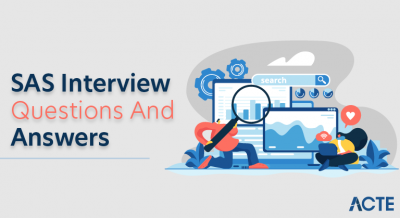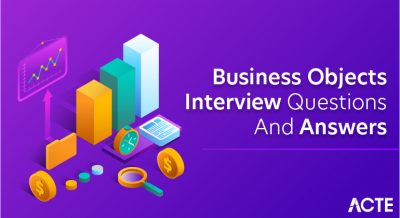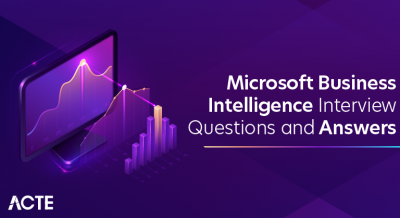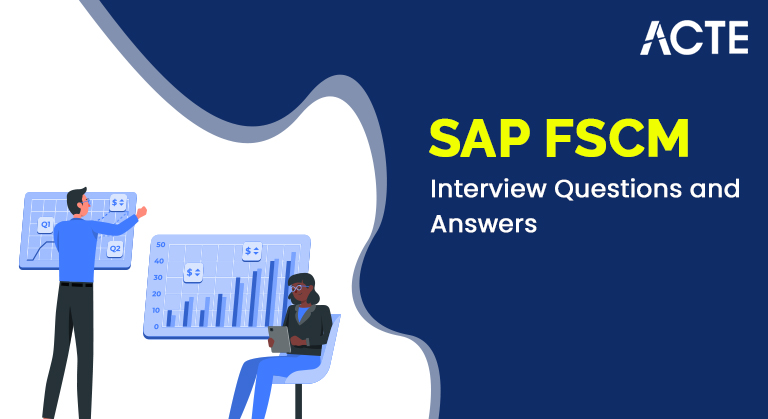
If you’re looking for SAP FSCM Interview Questions & Answers for Experienced & Freshers, you are in the right place. There are a lot of opportunities from many reputed companies in the world. According to research SAP, FSCM has a market share of about 0.1%. So, You still have the opportunity to move ahead in your career in SAP FSCM. ACTE offers advanced SAP FSCM Interview Questions that helps you in cracking your interview & acquire your dream career as an SAP FSCM Developer.
1. What is SAP FSCM, and why is it important in financial management?
Ans:
SAP FSCM, or Financial Supply Chain Management, is an integrated SAP solution designed to optimize and streamline various financial processes within an organization. It includes modules that focus on credit management, collection management, dispute management, and financial and risk management. It is essential in financial management because it provides tools and processes for increasing liquidity, mitigating credit risks, streamlining collection, and improving the efficiency of financial operations overall.
2. Explain the key components of SAP FSCM.
Ans:
3. How does SAP FSCM contribute to liquidity management?
Ans:
SAP FSCM contributes to liquidity management by providing real-time insight into cash positions, enabling organizations to forecast and plan liquidity effectively. It streamlines processes related to cash concentration, ensures optimal use of funds, and facilitates decision-making to maintain a healthy cash flow.
4. What is credit management in SAP FSCM, and why is it crucial?
Ans:
Credit Management in SAP FSCM includes evaluating and monitoring the creditworthiness of customers, setting credit limits, and automating credit processes. It is essential because it helps organizations make informed decisions about granting credit, minimizing bad debt risk, and optimizing working capital. Effective credit management ensures that organizations maintain a healthy balance between sales and risk.
5. What role does SAP FSCM play in working capital optimization?
Ans:
SAP FSCM plays a crucial role in optimizing working capital through several vital functions :
- Improved cash flow
- Effective credit management
- Days Sales Outstanding (DSO)
- Effective dispute resolution
- Treasury integration
6. How does SAP FSCM address the challenges of global cash visibility?
Ans:
- SAP FSCM provides a real-time overview of cash positions across different accounts and regions.
- It consolidates cash balances, facilitates accurate forecasting, and optimizes global cash management.
7. How does SAP FSCM automate credit scoring processes?
Ans:
SAP FSCM streamlines credit scoring by assigning numerical values to factors such as payment history and financial stability. Automation ensures consistency and enables informed decisions about loan approvals and limits. This standardized approach based on industry best practices increases efficiency and accuracy and contributes to overall sound financial management.
8. Explain the role of collections management in SAP FSCM.
Ans:
Collection management in SAP FSCM plays a crucial role in optimizing cash flow and reducing days sales outstanding (DSO). It automates and streamlines the receivables management process with a focus on the effective collection of outstanding payments from customers. Key features include creating worklists for collection agents, prioritizing overdue items, and providing a centralized platform to communicate with customers about outstanding invoices.
9. What is the purpose of dispute management in SAP FSCM?
Ans:
Dispute Management in SAP FSCM is used to resolve disputes related to invoices or payments effectively. It provides a centralized platform for tracking and managing disputes and facilitates communication between the finance team and customers. The system enables documentation of disputes, supporting evidentiary attachments, and resolution workflows. The ultimate goal is to streamline the resolution process, reduce dispute resolution time, and increase customer satisfaction by ensuring accurate and timely resolution of payment-related issues.
10. Explain the relationship between SAP FSCM and SAP In-House Cash.
Ans:
- SAP FSCM and SAP In-House Cash work together to optimize cash and liquidity management.
- SAP In-House Cash centralizes internal and external payments, while FSCM improves visibility and control over the entire financial supply chain.
- Together, they provide a comprehensive solution for effective internal cash management.
11. How does SAP FSCM contribute to reducing bad debts?
Ans:
- SAP FSCM assesses and monitors the creditworthiness of customers, thereby preventing loans to high-risk customers.
- An overview of credit limits in real-time and automated credit processes minimize the risk of bad debts.
- Debt collection management streamlines receivables, ensures timely payments, and reduces the likelihood of overdue accounts becoming bad debts.
12. How does SAP FSCM support treasury and risk management?
Ans:
SAP FSCM supports treasury and risk management by integrating various treasury functions into the overall financial supply chain. It provides tools for managing financial instruments, market risks, and regulatory compliance. The system enables organizations to monitor and analyze market conditions, assess and mitigate financial risks, and ensure compliance with regulatory requirements. By centralizing treasury and risk management functions, SAP FSCM helps organizations make informed decisions, optimize investment strategies, and protect financial stability.
13. Can you describe the possibilities of integrating SAP FSCM with other SAP modules?
Ans:
SAP FSCM ensures seamless integration with SAP ERP and SAP S/4HANA and supports a unified financial environment. Its integration capabilities support consistent data flow, eliminate silos and ensure accuracy. Integration with SAP ERP, for example, synchronizes financial data across modules, increases operational efficiency, and enables real-time reporting. This integration provides a comprehensive view of the financial environment and optimizes organizational processes.
14. What are the key features of SAP Credit Management?
Ans:
- Automated credit scoring
- Management of credit limits
- Credit rules and working procedures.
- Real-time monitoring,
15. How does SAP FSCM support cash concentration?
Ans:
Centralized management : SAP FSCM centralizes cash concentration by consolidating cash from different accounts.
Automated processes : Automates cash concentration processes, reducing manual effort and errors.
Efficient cash flow : Facilitates optimal use of funds and improves overall liquidity management.
Real-time visibility : Provides real-time visibility into cash concentration activities for accurate decision-making.
Integrated Banking : Integrates with banking systems for seamless execution and reconciliation of cash concentration transactions.
16. What does credit limit adjustment mean in SAP FSCM?
Ans:
In SAP FSCM, credit limit adjustments are of great importance as they allow organizations to dynamically adjust credit limits based on evolving customer creditworthiness and changing financial conditions. This adaptability ensures that credit limits closely match each customer’s real-time risk assessment. By facilitating timely adjustments, SAP FSCM enables businesses
17. Explain the concept of credit exposure in SAP FSCM.
Ans:
Credit exposure in SAP FSCM refers to the potential financial loss an organization may face as a result of a customer default. It includes real-time monitoring and management of financial risks associated with providing credit to customers. By continuously evaluating credit exposure, SAP FSCM enables organizations to make informed decisions, such as adjusting credit limits or implementing risk mitigation strategies, ensuring financial stability, and minimizing the impact of default losses.
18. How do you manage cross-currency transactions in SAP FSCM?
Ans:
SAP FSCM efficiently handles cross-currency transactions by providing tools for seamless currency conversion and managing related currency risks. The system ensures the accuracy of financial transactions involving different currencies and supports global business operations. By automating and streamlining these processes, SAP FSCM contributes to efficient and error-free cross-currency transactions, increases financial transparency, and minimizes potential currency-related issues.
19. What are the benefits of implementing SAP FSCM?
Ans:
| Benefit | Description | |
| Cash Flow Management |
Improved visibility, streamlined collections, and better working capital management. |
|
| Credit Management | Automated risk assessment, real-time credit monitoring, and reduced credit-related risks. | |
| Accounts Receivable | Streamlined invoicing, faster reconciliation, and improved dispute resolution. |
20. Explain the contribution of SAP FSCM to the optimization of dispute resolution processes.
Ans:
Centralized Platform : Provides a centralized platform for tracking and managing payment disputes.
Automation : Streamlines dispute resolution processes, reducing time and resources.
Better customer relations : A practical solution contributes to increased customer satisfaction.
Agile Financial Supply Chain : Optimizes dispute resolution for a more responsive financial supply chain.
21. What is the purpose of SAP Biller Direct in FSCM?
Ans:
SAP Biller Direct in FSCM is used to provide customers with a direct and interactive platform for managing billing processes. It increases transparency by allowing customers to process invoices and payments independently, reducing reliance on manual intervention. This self-service capability improves customer satisfaction, simplifies invoicing interactions, and contributes to a more efficient and customer-centric financial supply chain.
22. How do you facilitate credit limit monitoring and alerts in SAP FSCM?
Ans:
SAP FSCM facilitates proactive monitoring of credit limits by continuously monitoring credit limits in real-time. The system generates alerts on potential violations or deviations from established credit parameters. This real-time monitoring and warning mechanism allows organizations to respond quickly to changing credit conditions, enables effective risk management, and ensures that credit exposures are in line with established financial policies.
23. Explain the role of SAP FSCM in compliance with financial regulations.
Ans:
Seamless integration : Integrates with regulatory compliance requirements.
Process automation : Automates financial processes, ensuring accuracy and compliance.
Reduced regulatory risks : Proactive compliance measures reduce the risk of regulatory penalties.
24. What is risk management in financial processes through SAP FSCM?
Ans:
Data Analysis Tools : Includes robust risk analysis tools for effective risk management.
Overview of Market Conditions : Provides insight into market risks and changing financial variables.
Informed decision-making : Enables organizations to make informed decisions based on analytical insights.
Adaptability to change : Increases adaptability to the changing financial environment through proactive risk analysis.
25. What role does SAP FSCM play in reducing days out of sales (DSO)?
Ans:
Simplified receivables management : Automates receivables management processes for faster debt collection.
Improved cash flow : Accelerates the collection of outstanding payments and improves cash flow.
Shortened cash conversion cycle : Reduces DSO metrics by accelerating receivables turnover.
Optimized Working Capital : Contributes to the optimization of working capital through efficient receivables processes.
26. What are the benefits of implementing SAP FSCM?
Ans:
Improved liquidity management : Real-time visibility of cash positions improves liquidity planning.
Improved credit risk control : Automated credit scoring and monitoring minimize bad debt risk.
Simplified financial processes : Integration with SAP modules ensures consistent and efficient financial operations.
Better decision-making : Real-time statistics enable informed decisions and contribute to overall financial stability.
27. Explain the contribution of SAP FSCM to the optimization of dispute resolution processes.
Ans:
Centralized Platform : Provides a centralized platform for tracking and managing payment disputes.
Automation : Streamlines dispute resolution processes, reducing time and resources.
Better customer relations : A practical solution contributes to increased customer satisfaction.
Agile Financial Supply Chain : Optimizes dispute resolution for a more responsive financial supply chain.
28. How does SAP FSCM automate the credit approval process?
Ans:
SAP FSCM automates the loan approval process using predefined factors such as payment history and financial stability to assign numerical values. This automated credit scoring enables dynamic adjustments to credit limits in real-time and ensures a standardized and efficient approach to credit approval.
29. What tools does SAP FSCM provide for customer dispute management?
Ans:
SAP FSCM for customer dispute management provides a centralized platform equipped with tools such as documentation and attachments for evidence, simplified workflow management, and efficient communication channels. These features increase the efficiency of dispute-resolution processes, reduce the time and resources required to resolve payment-related issues and improve overall customer satisfaction
30. How does SAP FSCM support real-time reporting and analytics?
Ans:
SAP FSCM supports real-time reporting and analytics and seamlessly integrates with SAP modules, facilitating a unified and up-to-date data environment. The system provides user-friendly dashboards and reporting tools that enable quick insights and informed decision-making by automating the flow of data across various financial modules.
31. Explain the integration of SAP FSCM with credit insurance systems.
Ans:
When it comes to integration with credit insurance systems, SAP FSCM ensures seamless data exchange and leverages credit insurance data for practical credit risk assessment and mitigation. Adhering to credit insurance policies and regulations, the integration optimizes risk management strategies and ensures comprehensive coverage and compliance with industry standards.
32. How does SAP FSCM optimize cash application processes?
Ans:
As for cash application processes, SAP FSCM optimizes them by automating the matching of incoming payments with open receivables. The system uses intelligent algorithms to identify and apply cash to the correct customer accounts, minimizing manual effort when reconciling payments. The result is timely and accurate use of cash, improving the overall effectiveness of cash management and ensuring accurate financial records.
33. What problems does SAP FSCM solve in the financial supply chain?
Ans:
Credit Risk Management : Addresses credit risk issues through increased operational.
efficiency : Streamlines financial processes, reduces manual effort, and improves accuracy.
Collection optimization : Simplifies collection management and reduces days of sales outstanding (DSO).
Dispute Resolution : Provides tools for adequate settlement and resolution of payment disputes.
34. How does SAP FSCM contribute to efficient invoicing processes?
Ans:
Automation : Automates billing workflows, reducing manual intervention and errors.
Biller Direct feature : Offers customers a self-service invoice management platform and promotes transparency.
Improved transparency : Increases transparency in billing interactions and promotes better customer relationships.
35. What is the role of SAP FSCM in cash forecast optimization?
Ans:
Real-time cash visibility : Provides a real-time view of cash positions and consolidates cash balances.
Accurate Forecasting : Facilitates accurate forecasting by minimizing discrepancies and providing up-to-date financial data.
Effective working capital management : Enables organizations to optimize working capital through improved cash forecasting.
Proactive decision-making : Supports proactive decision-making based on reliable cash flow projections.
36. How does SAP FSCM handle automated payment processing?
Ans:
Increased operational efficiency : Streamlines financial processes, reduces manual effort, and improves accuracy.
Improved cash flow : Optimizes liquidity management and contributes to stable and predictable cash flow.
Insufficient Debt Reduction : Minimizes credit risk through effective credit management and reduces the likelihood of bad debts.
37. What things should you pay attention to when handling customer-related financial functions?
Ans:
Certain things generally matter. The main thing is to ensure how to offer the item to the client without offering any markup. Furthermore, one needs to focus on the client’s exchange history to understand the decisions and inclinations, as this would be a valuable methodology. In addition, it is essential to consider the risk assessment of the client carefully.
38. What do you mean by “Y” in product flow?
Ans:
Basically, it is a graphical or appropriate display of the apparent number of phases identified with the improvement of the subject and how it is further prepared for the marketers or clients. It really is one of the main points of the elegantly bound advice on how to deal with the modernization of this procedure, and a great deal of clients pay extraordinary attention to it.
39. What are the advantages that an organization can have with In-house Cash?
Ans:
- Necessity of checking the general number of financial balances
- Tax abuse
- Quick installments of external exchanges (perils may be involved, though).
40. How would you handle arrears from customers in FSCM?
Ans:
In SAP Financial Supply Chain Management (FSCM), handling arrears from customers involves a systematic approach. Firstly, identify overdue accounts through FSCM’s receivables management functionality. Implement proactive collections strategies, automated dunning processes, and personalized communications to encourage timely payments. Utilize FSCM’s dispute management features to resolve any outstanding issues, fostering a collaborative approach to address arrears and maintain positive customer relationships.
41. How does SAP FSCM support dynamic credit limit adjustments?
Ans:
SAP FSCM supports dynamic credit limit adjustments through real-time monitoring and automatic credit scoring. As the creditworthiness of customers changes, the system allows for immediate adjustments to credit limits. This dynamic capability ensures that credit limits are aligned with current risk assessments, providing organizations with agile credit management.
42. What are the critical considerations for a successful SAP FSCM implementation?
Ans:
Through business process analysis : Understand and analyze existing financial processes for seamless integration.
Stakeholder Engagement : Engage key stakeholders in collaboration and alignment of implementation with organizational goals.
User training : Provide users with comprehensive training to use the system effectively.
Adherence to best practices : Implement SAP FSCM according to industry best practices to maximize benefits and ensure compliance
43. Explain the role of SAP FSCM in improving collaboration between finance and sales teams.
Ans:
SAP FSCM improves collaboration by providing real-time insight into customer credit information. Facilitates simplified credit approvals, collections, and financial interactions and promotes better communication between finance and sales teams. This transparency ensures that both teams work cohesively, leading to better decision-making and customer relationship management.
44. How does SAP FSCM solve problems related to dispersed financial operations?
Ans:
SAP FSCM solves the problems related to dispersed financial operations by centralizing and standardizing financial processes. Through seamless integration with various SAP modules, the system ensures consistent data flow and eliminates information silos. This centralized approach increases the visibility, accuracy, and efficiency of financial operations, which is especially beneficial for organizations with geographically dispersed financial activities.
45. What is the relationship between SAP FSCM and Vendor Invoice Management (VIM)?
Ans:
SAP FSCM and Vendor Invoice Management (VIM) complement each other in optimizing invoice processing. While SAP FSCM focuses on credit management, collections, and the overall financial supply chain, VIM focuses explicitly on the efficient handling and processing of supplier invoices. Integration ensures a comprehensive end-to-end approach and streamlines financial interactions with customers and suppliers within the organization. This cooperation increases overall financial efficiency and transparency.
46. How does SAP FSCM improve communication between finance and customers?
Ans:
Self-service platforms : Provides customers with platforms such as SAP Biller Direct for independent invoice and payment management.
Real-time visibility : Enables customers to access account information in real-time and promotes transparency.
Proactive Communication : Facilitates proactive communication through automatic alerts and notifications.
47. What is the role of SAP FSCM in optimizing credit risk mitigation strategies?
Ans:
Automated Credit Scoring : Uses automated credit scoring to assess a customer’s creditworthiness.
Dynamic Credit Limits : Enables real-time credit limit adjustments based on changing risk assessments.
Early Warning Systems : Establishes early warning systems for potential credit risks through real-time monitoring.
48. How does SAP FSCM resolve billing discrepancies and disputes?
Ans:
Centralized Platform : Provides a centralized platform for tracking and managing billing discrepancies.
Workflow Management : Streamlines dispute resolution workflows and ensures efficient processing.
Documentation tools : Supports documentation of disputes with attached evidence.
49. What reporting tools does SAP FSCM provide for financial analysis?
Ans:
User-friendly dashboards : Offers user-friendly dashboards for quick and easy access to financial data.
Customizable Reports : Provides tools for creating customizable reports tailored to specific financial analysis needs.
Data visualization : Includes data visualization tools for a clearer view of financial performance.
50. Explain the role of SAP FSCM in reducing operational costs in financial processes.
Ans:
Process Automation : Reduces manual effort by automating credit management, collection, and invoicing.
Minimized errors : Automation minimizes errors associated with manual data entry and processing.
Streamlined Workflows : Streamlines financial processes and improves overall operational efficiency.
51. Explain the term “dispute”?
Ans:
Basically, it is a circumstance where a client, seller, retailer, provider, distributor, or whoever the governing association neglects to recognize the arrangement of the organization. The question may be due to confusion, association, or some other assembly. All in all, most debates arise because of the variables that are associated with budget exchanges.
52. Can FSCM have a direct impact on organizational portability and costs?
Ans:
It really directly affects both these modules, which are significant in such a business. With viable financial supply chain management, clients can fundamentally reduce costs, which are no longer changing, and they can keep an eye on cost developments. Productivity can clearly be guaranteed by reducing costs.
53. Explain the term “Loan collection”?
Ans:
Basically, it is the strategy of the organization to get the upcoming amount from the merchants, wholesalers, retailers, or clients in a certain period. This is mainly to avoid any tendency and ensure better client connection.
54. How do you implement an SAP FSCM project, and what are the pros and cons associated with it?
Ans:
Realizing such an enterprise is a task that requires disconnection at every stage. This is because the cycles are different in many cases, and clients can isolate them according to their needs. The greatest thing about this innovation is that more than 80% of the businesses identified with implantation are pre-planned. Rest should be possible thanks to the correct execution of the programming.
55. What happens if the customer is disappeared or untraceable?
Ans:
If the customer has disappeared or is untraceable, charges may be charged from business to business.
56. Name and compare the processes in supply chain financial management that are important.
Ans:
- It is the company’s view. It is the supplier’s view.
- Quotation is not always necessary. The same is of paramount importance in this cycle
- Sellers don’t always need it. Sellers often do.
57. What benefits can effective Financial Supply Chain Management (FSCM) bring to an organization?
Ans:
- Financial supply chain management ensures the availability of finance at the right time
- Better customer relationship management can also be ensured.
- Timely delivery of products to sellers and customers.
- Production and stock availability can be closely monitored
- Users can easily make sure that there is no loss due to any minor financial problems.
58. What advantages can an organization have with internal cash?
Ans:
- Checking the requirements for the total number of bank accounts
- Tax benefits
- Fast payments of external transactions (but risks may be involved).
59. What are the reasons why an organization should adopt SAP FSCM?
Ans:
Managing credit collection and the relevant process is a challenging job these days. This is due to changes in the nature of users and their preferences. Another significant issue is competition, which is obviously a challenge for any business these days. With SAP FSCM, all processes related to financial management in an organization can be easily improved. There are several features in the tool with the help of which users can quickly solve finance-related problems and improve the overall visibility of the business.
60. What things should you pay attention to when handling customer-related financial functions?
Ans:
Certain things matter to a great extent. The first thing is to make sure how to sell the product to the customer without any discount. Further, paying attention to the customer’s transaction history to understand the selection and preferences would be a helpful strategy. It is also essential to pay close attention to the customer’s risk assessment.
61. What do you understand by the term product flow?
Ans:
It is basically a graphical or orderly representation of all the stages that are related to the development of the product and how the sellers or customers further process it. In fact, strengthening this strategy is one of the main objectives of the financial supply chain management approach, and most users pay close attention to it.
62. Can FSCM have a direct impact on an organization’s profitability and costs?
Ans:
Yes, it has a direct impact on both these modules, which are very important in any business. By effectively managing the financial supply chain, users can significantly reduce expenses that are no longer important and can closely monitor the flow of expenses. By reducing costs, it is clear that profitability can be ensured with certainty.
63. Name one of the essential components of financial management.
Ans:
An essential aspect of financial management is budgeting. Budgeting involves planning and allocating financial resources for various activities and expenses in an organization. It helps set financial goals, monitor budgets, and use resources efficiently. By setting and following a budget, organizations can control costs, manage cash flow, and make financial decisions to achieve their overall goals.
64. What do you understand by the term Credit Collection (CC)?
Ans:
Credit Collection (CC) refers to the process of managing and collecting payments from customers or consumers who have debts or credit obligations. From a financial management perspective, credit collection is an essential part of ensuring that a business or organization receives the money owed by customers who purchased goods or services on credit.
65. What is customer master data used for in SAP FSCM (Financial Supply Chain Management)?
Ans:
Customer master data functionality in SAP FSCM is essential to provide detailed information about the customer to ensure effective financial management. This information is essential for credit management and helps organizations assess credit risk by determining credit limits and terms. It helps manage accounts by classifying customers based on their payment behavior, helps resolve disputes through contact information and preferences, and supports fire rates, electricity, and payment methods. Customer master data is integrated with other SAP modules to ensure the consistency of business processes, playing an essential role in informed decision-making and control of financial security in equipment.
66. How is customer master data created in SAP FSCM?
Ans:
In SAP FSCM, the customer creates a transaction in the input field where the user enters general details about the customer, including name, address, and contact form information. Credit-related information (such as credit limits and details) is determined for effective credit management and may also include collections and dispute management, including character pattern payment and search preferences. Electronic Invoice Submission and Payment (EBPP) settings will be made when necessary. After entering all the required information, the user will save the customer data and make it available for various financial processes in SAP FSCM. Specific steps and areas may vary depending on configuration and organizational needs.
67. What other information does the company code provide in SAP FSCM?
Ans:
Legal Information : The company code contains detailed information about the legal structure of the organization, its name, address, and registration information.
Chart of Accounts : This relates to a specific chart of accounts that determines the structure of the general ledger used for the preparation and reporting of financial information.
Currency values : Introducing the results recorded in the financial market helps accuracy and consolidation, especially in different organizations that control many benefits.
68. How does SAP FSCM’s customer market structure enable global access to customer information?
Ans:
Geographical Segmentation : The customer market structure allows users to segment customers based on their geographical location or the market they belong to. This segmentation can be defined at various levels, such as country, region, or continent.
Localization of Information : By associating customers with specific markets or countries within the customer market structure, organizations can localize and centralize relevant information. This includes details like currency, tax regulations, legal requirements, and language preferences specific to each market.
69. What are examples of additional data included in customer master data in SAP FSCM?
Ans:
Terms and Conditions : Specifies the maximum amount of credit allowed per customer and the conditions under which the credit is extended.
Credit Control Area : A control area that associates customers with specific credit scores and allows credit control according to the needs of the organization.
Payment History : Record the customer’s payment history behavior, including details of past transactions, late payments, or significant deductions.
70. How does SAP FSCM’s communication system integrate with a third-party system?
Ans:
Define integration requirements : Clarify integration requirements, including specific information to be exchanged between SAP FSCM and Protect What.
Middleware or integration layer : Use middleware or integration layer to facilitate communication between SAP FSCM and Protect Objects. This may include using APIs, plugins, or other integration tools.
Data mapping and transformation : Make sure the input data and design are mapped between the two systems. SAP FSCM data may need to be modified to comply with the Tax Shelter Regulations.
71. Why does SAP FSCM use tax codes for profit calculation?
Ans:
In the SAP Financial Supply Chain Management (FSCM) system, tax codes play an important role in revenue calculations for several reasons. First, tax compliance is essential, and compliance with the law is possible through the use of appropriate tax rates and regulations to comply with local and international tax laws. Accuracy of financial reporting is guaranteed because tax-related information is included in the financial statements, thus ensuring transparency regarding the financial position and activities of the organization.
72. What are the benefits of the customer master data structure in SAP FSCM?
Ans:
Better Customer Service : Provides a centralized and comprehensive view of customer information, including contact information, credit limits, and payment history.
Advanced Credit Management : Allows organizations to set appropriate credit limits, provide effective credit management, define terms, and evaluate customers’ creditworthiness.
73. What aspects does the presentation cover?
Ans:
Introduction : Setting the stage by introducing the topic and the presenter and providing an overview of what the audience can expect.
Agenda : Outline the key points or topics that will be covered during the presentation.
Background/Context : Providing necessary background information or context to help the audience understand the subject matter.
Primary Content : Presenting the main ideas, information, or arguments related to the topic. This is often the core of the presentation.
Data and Statistics : Including relevant data and statistics to support arguments or provide evidence.
Key Takeaways : Summarize the main points or messages that the audience should remember from the presentation.
Q&A Session : Allowing time for questions and answers, encouraging audience interaction.
Conclusion : Wrapping up the presentation by summarizing key points, restating the main message, and providing a conclusion.
74. Where should users check before proceeding with configuration parts?
Ans:
Before configuring a software system, users should consult documentation and release notes, meet prerequisites, verify, users should consult documentation and release notes, meet prerequisites, verify permissions, implement backups, conduct testing, and communicate with stakeholders to ensure a smooth and risk-minimized configuration process.
75. What is the purpose of the sap from Business Partner application?
Ans:
The SAP Business Partner application in the SAP ERP system acts as a centralized repository for managing master data related to business partners, including customers and vendors. It ensures data consistency across modules, facilitating efficient transaction processing and supporting informed decision-making through streamlined reporting and analytics. The application’s holistic view and integration capabilities enhance overall business processes.
76. What is involved in creating an account in SAP financial supply chain management?
Ans:
Accessing SAP FSCM : Log in to the SAP FSCM system using appropriate credentials and access permissions.
Navigating to Account Management : Navigate to the relevant transaction or menu option for account management within the SAP FSCM module.
Entering Customer Details : Input comprehensive details about the customer, including name, address, contact information, and any other relevant identifiers. This information forms the core of the customer master data.
77. Why does SAP FSCM use tax codes for profit calculation?
Ans:
To enable bidirectional communication between customers and business partners in SAP FSCM, organizations need to configure communication channels (such as email or EDI), maintain accurate customer and business partner master data, and implement secure protocols for information exchange. Additional considerations include :
- Configuring electronic bill presentation and payment (EBPP).
- Integrating with CRM systems.
- Setting up notification preferences.
78. What is the role of a business partner in the FSCM module?
Ans:
In the SAP Financial Supply Chain Management (FSCM) module, a business partner serves as a central entity for managing comprehensive master data related to both customers and vendors. It plays a crucial role in credit management for customers, facilitates efficient collections and dispute resolution, and supports vendor relationship management. The business partner concept is integrated across SAP modules, ensuring consistency in data, and it is instrumental in electronic bill presentation and payment processes, transaction processing, and strategic decision-making through reporting and analytics within the FSCM framework.
79. How is the integration between the customer and business partner established?
Ans:
Integration between customers and business partners in SAP systems is achieved through a shared master data concept. Business partners are created as central entities, and roles such as “Customer” or “Vendor” are assigned based on the business relationship. This integrated approach ensures centralized data storage, consistency in transactions, and real-time updates across relevant SAP modules, allowing for efficient and unified management of customer and vendor relationships.
80. What are the steps involved in setting up a business partner?
Ans:
Accessing SAP Transaction : Log in to the SAP system and navigate to the relevant transaction or menu for business partner creation.
Selecting Business Partner Type : Choose the appropriate business partner type, such as “Customer” or “Vendor,” based on the nature of the business relationship.
Entering General Information : Input general information, including name, address, contact details, and any other relevant identifiers for the business partner.
81. What is involved in creating a system with the same customer numbers as the business partners?
Ans:
Creating a system with the same customer numbers as business partners in SAP involves aligning customer and business partner master data. Initially, configure the system to recognize customer numbers as business partner keys, ensuring consistency across modules. During business partner creation, assign roles such as “Customer” and maintain customer-specific details like credit limits, establishing a seamless integration that allows data to be shared between customer and business partner records. This setup streamlines processes, enhancing data consistency and facilitating efficient transactions within the SAP system.
82. What is the need of customers’customers to buy goods?
Ans:
Satisfying Needs and Wants : Customers buy goods to fulfill their basic needs, such as food, clothing, and shelter, as well as wants and desires for products that enhance their lifestyle or well-being.
Problem Solving : Purchases are often driven by the need to solve specific problems or challenges. Customers seek products that address a particular issue or improve their quality of life.
83. What happens if the dispute is not justified?
Ans:
If a dispute is found to be unjustified, the resolution process involves clarifying the misunderstanding with the customer or business partner. The involved parties, often customer service representatives or dispute resolution teams, communicate transparently to identify the source of the discrepancy and provide evidence or documentation to support the resolution. Timely and effective communication is crucial to maintaining a positive customer relationship and ensuring a fair and accurate resolution of the dispute.
84. What is the purpose of the SAP FSCM dispute municipal test cases?
Ans:
Scenario Validation : SAP FSCM dispute municipal test cases aim to validate the system’s ability to handle specific scenarios related to municipal transactions, ensuring that the dispute management functionality aligns with the unique requirements of local government entities.
Functional Testing : Test cases cover functional aspects of dispute resolution within SAP FSCM, including testing for inaccuracies in municipal billing, pricing discrepancies, or issues related to taxation, which are common scenarios in local government financial processes.
85. What is SAP?
Ans:
SAP, or ‘Systems, Application and Products,’ is an industry-standard Enterprise Resource Planning (ERP) software developed for the management of business operations and customer relations. It is the world’s leading vendor of ERP software. Organizations can utilize SAP to manage every aspect of their business, from finance and HR to procurement and logistics.
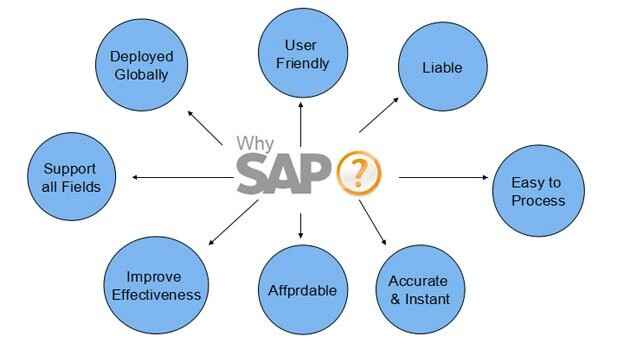
86. How does SAP FSCM handle customer credit ratings and what factors influence the rating process?
Ans:
SAP FSCM automates customer credit evaluation through a systematic evaluation process. Key factors taken into consideration include payment history, financial stability, credit utilization, and compliance with credit terms. The system dynamically adjusts credit limits based on real-time evaluation and thus ensures a comprehensive and up-to-date view of the customer’s creditworthiness.
87. What are examples of critical functions in SAP Credit Management and how do they reduce credit risk?
Ans:
Automated Credit Scoring : Assigns numerical values to factors such as payment history to help assess creditworthiness.
Credit limit adjustments : Dynamically adjust credit limits in real-time based on changing risk assessments.
Early warning systems : Introduces alerts on potential credit risks, enabling proactive risk management.
Real-time monitoring : Provides continuous monitoring of credit exposure and ensures timely response to changing credit conditions.
88. Describe the role of SAP Biller Direct in SAP FSCM and its impact on customer interactions.
Ans:
SAP Biller Direct serves as a self-service platform that enables customers to manage invoices, payments, and disputes independently. It improves customer interactions by providing transparency into billing processes, enabling timely and accurate payments, and fostering a proactive and collaborative relationship between the finance department and customers.
89. How does SAP FSCM contribute to optimizing cash visibility, especially in complex financial structures?
Ans:
SAP FSCM optimizes cash visibility by consolidating and centralizing cash positions in real-time. Integration with various financial modules ensures accurate and up-to-date information and supports effective cash forecasting in complex financial structures. This capability enables organizations to make informed decisions and maintain optimal
90. What considerations should be taken into account for a successful SAP FSCM upgrade?
Ans:
Thorough planning : Detailed planning to understand business processes, dependencies, and potential risks.
Stakeholder Engagement : Engaging key stakeholders to ensure alignment with organizational goals.
User training : Comprehensive training programs to familiarize users with new features and workflows.
Testing Procedures : Rigorous testing of the upgraded system to identify and resolve any issues.
91. Describe the impact of SAP FSCM on optimizing dispute resolution processes.
Ans:
SAP FSCM significantly streamlines dispute resolution by providing a centralized platform for managing discrepancies. The system automates workflows, speeds up communication between finance and customers, and ensures transparency in dispute resolution. This proactive approach not only reduces time and resources spent on dispute resolution but also helps maintain positive customer relationships. Through real-time updates and clear communication channels, SAP FSCM promotes customer trust and satisfaction.



